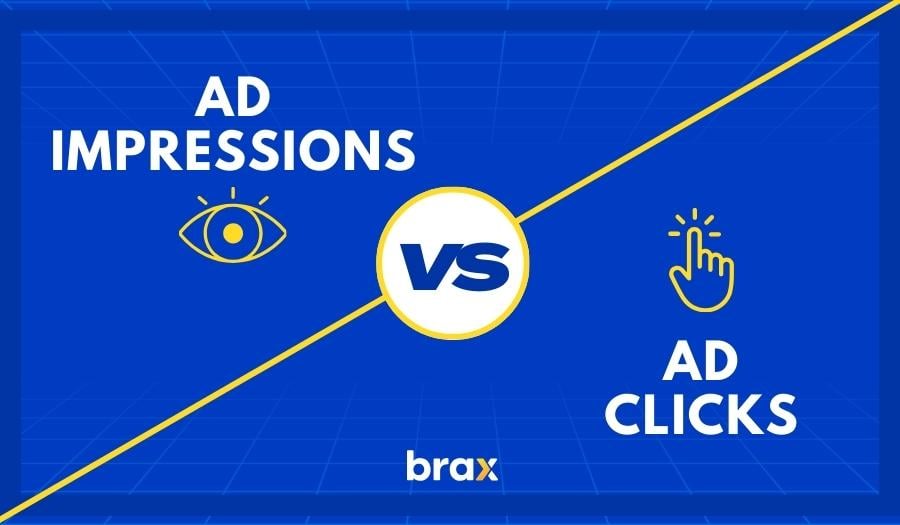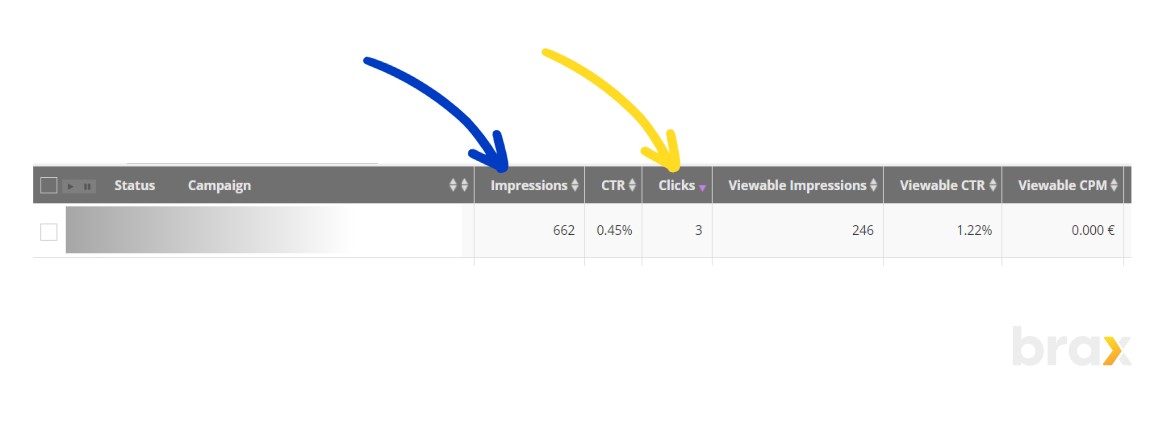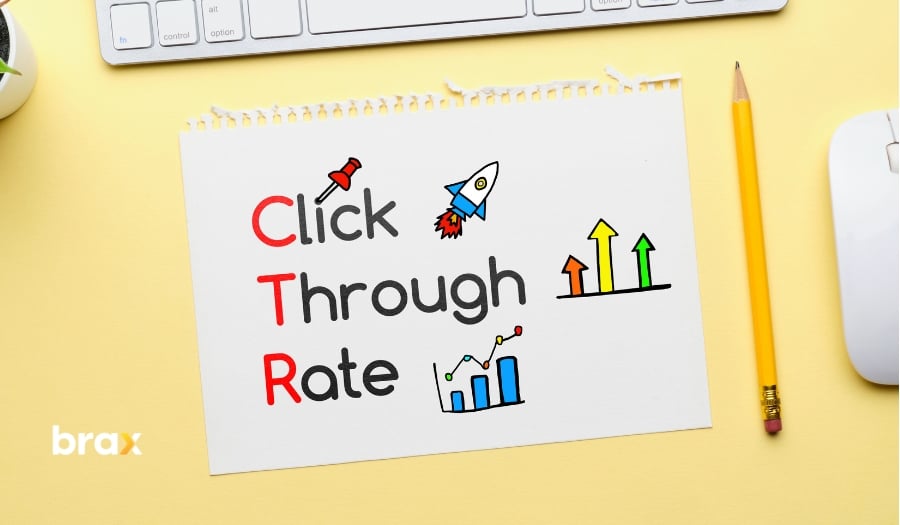Remember the last time you launched a digital marketing campaign? You were probably neck-deep in numbers, fixated on metrics like ad impressions and ad clicks.
Like many marketers, you found yourself caught in a dilemma: Which one matters more? This predicament is like being on a seesaw, with each metric propelling you up and down in your quest for marketing supremacy.
To help you understand them better, we will delve into the heart of these metrics. It's our mission to address your present concerns and arm you with the knowledge to navigate this seesaw with finesse.
So buckle up, fellow marketers, as we decode the enigma of ad impressions and ad clicks, and empower you to make informed decisions for your next campaign.
Ad Clicks and Ad Impressions Explained
It's time to clear the fog on these two juggernauts of digital marketing jargon — 'Ad Clicks' and 'Ad Impressions'.
You might think of them as the Beyonce and Jay-Z of your marketing campaign. Both vital, both commanding attention, but each playing a unique role in your strategy.
What are Ad Impressions?
'Ad Impressions' is essentially a measure of how many times your advertisement appears on someone's screen.
Each appearance counts as one impression, signifying that your ad has made its presence known to consumers, regardless of their response.
An ad impression is counted no matter how small the part of an ad appears on the user, and whether or not the user has seen the ad.
There are various types of ad impressions, but one that you may often encounter in many native advertising platforms is the Viewable Impression, which is slightly more specific than plain ad impressions.
For an impression to be considered 'viewable', at least 50% of your ad must be visible on the screen for a minimum of two seconds.
While it is certainly debatable as to whether two seconds of half an ad is enough to make an actual real-life impression to your audience, this is how the industry defines it (and we believe it is important that you know how they actually count.)
What are Ad Clicks?
This is another crucial component of your digital marketing metrics.
'Ad Clicks' are counted when a user actively engages with your advertisement by clicking on it.

Each ad click signifies a user's interest and intent. They've moved from just seeing your ad (impression) to showing curiosity about what you have to offer (click).
This interactive step is key to driving potential customers towards conversion, be it a product purchase, website visit, or any other desired action.
However, clicking an ad cannot be equated to the user seeing your landing page. That's another metric called Page View, although not many platforms have this metric due to having additional requirements such as being able to track whether a page has loaded in full or not.
Which One Should You Use?
In reality, both Ad Impressions and Ad Clicks are vital metrics in online advertising. The importance of these metrics can vary depending on the specific context and goals of an advertising campaign.
Let's take a look at when you should focus on each one.
When to Focus on Ad Impressions
Depending on your campaign's objectives, there are distinct scenarios where ad impressions can serve as the key metric for gauging success.
When the primary objective is to increase brand awareness
When boosting brand awareness, Ad Impressions is the critical tool. Each impression counts as exposure for your brand and an opportunity to stand out.
Picture yourself strolling down a bustling street, encountering the same billboard day after day. Even if you don't pause to read it, you still become acquainted with the brand. This is precisely the role that ad impressions play in the digital realm.
Remember, familiarity breeds recognition. And regular exposure to your ads can build this familiarity.
Every impression represents a potential touchpoint with a consumer, putting your brand out there for people to see and recognize.
Your ad doesn't need to be clicked to have an impact — simply appearing on a screen matters.
It's a chance for your brand to say, "I'm here". It's a silent yet powerful interaction.

The more impressions you have, the more familiar your brand becomes to users. And while they don't interact with your ad right away, you are still capturing their attention.
This familiarity is crucial in building brand recognition and trust, two key components of any successful online marketing strategy.
To increase visibility or reach
For campaigns where increasing visibility and expanding reach are the primary objectives, ad impressions become a crucial metric. Reach refers to the total number of unique users who have seen your ad. It's a useful figure to understand the potential scale of your audience.
A high number of ad impressions indicates a wide reach. It's your brand casting a wide net in the vast ocean of the internet. This means your ad is getting significant exposure, and your message is spreading.
By tracking ad impressions, we can get a clear picture of how far our message is spreading.
If we see a high number of impressions, it means our ad is reaching a wide audience. On the contrary, a low number of impressions may indicate that our targeting needs adjustment, or that our ad isn't engaging enough to stand out in crowded digital spaces (provided that your bid is high enough).
During broad or mass marketing campaigns
If your marketing strategy involves reaching as many people as possible, such as during a major sale or event, you should track impressions to gauge your success.
For example, you might notice Black Friday sale ads by various companies recently. Even while their sale has not yet started, they are informing people that a sale is coming.
It's like shouting through a megaphone — the goal is to attract attention without necessarily aiming for a conversion right away.
When trying to establish market saturation
There comes a point in marketing where you are already halfway through: your target audience knows who you are, and your brand is one of their choices. At this juncture, impressions serve as an excellent metric to gauge how well you have penetrated the market.
If your goal is to dominate the market or make sure your brand is on top of mind for as many people as possible, then impressions are a good metric to focus on.
When your product or service is already widely known, it's more important to ensure that people don't forget about you rather than trying to attract new customers. Impressions can help you track your ongoing presence and visibility in the market.
For competitive analysis
Ad impressions provide insights into the performance of your ads compared to competitors. If you notice fewer impressions, it suggests that your competitors' ads are outperforming yours in programmatic bidding.
It's time to increase your bids and step up the game.
The Win Rate, a calculated metric derived from Ad Impressions, indicates the percentage of ad appearances your ad 'wins' or achieves. A low win rate signifies that your bid lacks competitiveness.
You should then improve your bid strategy to gain an edge in the bidding arena.

If your advertising platform charges on a cost-per-thousand-impressions (CPM) basis
If the native advertising platform you're using charges on a cost-per-thousand-impressions (CPM) basis, then monitoring ad impressions becomes paramount. This is because your costs will directly hinge on the number of ad impressions.
Generally, CPM-based campaigns are priced lower than cost-per-click (CPC) campaigns. This is primarily because, despite the extensive reach, engagement isn't guaranteed with CPM.
The upside of this is that no matter the number of clicks you get, you'll only pay for the price of the impression. So, if you have a high click-thru rate (percentage of people who have clicked your ad as compared to the percentage of people who have likely seen your ad), then you'll be at an advantage.
Essentially, with CPM, you're paying for potential visibility, not assured interaction. Hence, understanding the impression count becomes crucial to manage and predict campaign costs effectively while optimizing your budget.
For Performance Benchmark
Ad impressions serve as a pivotal performance benchmark for all other metrics in your digital marketing campaigns. They provide a baseline to evaluate the effectiveness and overall performance of your ad.
Each impression is an instance where your ad had the potential to influence a user, and therefore, a high number of impressions implies significant exposure and reach.
However, having a high number of impressions with low engagement or conversions might signal an issue with your ad's relevance or creativity.
In other words, your ad may be visible to many, but if it's not resonating with your audience, it's not performing effectively. This disparity between impressions and user engagement could suggest a need to enhance your ad content, make it more compelling, or adjust your target market.
Therefore, tracking ad impressions alongside other metrics like ad clicks and conversion rates can provide comprehensive insights into your ad campaign's performance.
It allows you to compare and contrast different aspects of the campaign, identify trends, and make necessary improvements for more successful future campaigns. This benchmarking exercise helps to optimize your marketing strategy for better reach, engagement, and ultimately, conversion.
When trying to uncover useful information about your target audience
Analyzing ad impressions over time, you may uncover a treasure trove of strategic information. It's like a treasure map, guiding you to the X that marks the spot of your target audience's peak activity time.
These 'hotspots' can be:
- different hours of the day when the users are most active
- specific demographics (age, gender, location) that garner more impressions
- the most common device, browser, or operating system used by your target market
...and other similar information.
Remember, impressions are not just numbers. They represent potential opportunities to engage with your target market. By actively monitoring and analyzing impressions, you unlock the power to drive meaningful connections, boost brand awareness, and ultimately achieve your paid advertising goals.
When to Focus on Ad Clicks
When the goal is to stimulate engagement and garner potential leads, focusing on Ad Clicks becomes indispensable. This metric is a clear indicator of user interest, revealing who is not only seeing your ad but also interacting with it.
Let's discuss it more clearly.
When the primary objective is to encourage action or conversion
When you're aiming for action or conversion, your click data becomes even more valuable. They serve as strong indicators of potential customers who have shown interest and are potentially ready to take the next step towards making a purchase, completing a form, downloading a resource, or engaging with your brand.
By analyzing and understanding the user behavior, you can tailor your marketing efforts and provide them with the right information or incentives to further encourage their conversion.

To Move Audiences Towards the Start of Your Marketing Funnel
A pivotal aspect of ad clicks is their role in ushering users into the first stage of the marketing funnel.
The moment a user clicks on your ad, they shift from passive viewer to active participant in your marketing journey.
It's the first step towards converting a casual browser into a customer. After all, impressions don't give us any level of assurance about where the user is really at.
By monitoring these clicks, we can not only gauge the initial interest in our brand but also track how many users are moving deeper into our marketing funnel. While impressions are a megaphone, ad clicks are the reply — the audible response of interested customers. They're the 'yes' in a sea of 'maybes'.
Identify Effective Ads Through Ad Clicks
One of the most significant benefits of tracking ad clicks is the ability to pinpoint which paid ads are the most effective.
An ad impression is a passive interaction, akin to a user glancing at a billboard as they stroll down the street. An ad click, by contrast, signifies active interest. It's the equivalent of a user stopping to take a closer look at the billboard, intrigued by what they see.
This active engagement brings the user one step closer to conversion, and is indicative of an ad that has managed to pique their interest.
Therefore, if you have multiple ads that have achieved the same reach, monitoring ad clicks can help you identify which among your ad creatives are truly resonating with your audience.
Ads that drive the most clicks are the ones that are not only catching the user's eye, but also compelling them to take action.
Tracking this metric across all your ads allows you to identify trends and patterns. You can see which headlines, visuals, or calls to action are the most effective at generating interest and prompting action.
Armed with this information, you can focus your efforts on crafting more of the ads that work, and less of the ones that don't, optimizing your campaigns for greater success.
During targeted campaigns
Targeted campaigns are like a guided missile, honed in on a specific audience. Here, ad clicks take center stage, acting as a barometer of resonance.
Your niche audience should, for all intents and purposes, interact with your promotion. If they don't, then your messaging may be wrong. Or you need to address your marketing angle.
For instance, you may be catering to eco-conscious consumers with a unique, sustainable product line. In this scenario, tracking ad clicks unveils how well your eco-friendly message resonates with this audience.
A high number of ad clicks signifies a well-targeted and engaging ad. If the click count is low, it's time for course correction.
For Remarketing Efforts
The importance of ad clicks is magnified during retargeting.
Retargeting refers to the strategies employed to re-engage users who have previously interacted with your brand. This may involve showing them ads that are specifically tailored to their previous interaction, browsing history, interests, and behaviors.

With mid-funnel and bottom-funnel customers, ad clicks are your headlights in the dark. These customers have crossed the awareness phase and are ready (or are being pushed) to move to the next stage of the marketing funnel.
Consider this — a customer eying your latest smartwatch model. They've read the features, compared options, and added them to the cart. However, they ended up leaving without buying anything.
You know they are interested, they just weren't ready to complete the purchase. The goal, now, is to get them back to complete the conversion by adding urgency or offering better deals.
An ad at this juncture should nudget them towards the purchase, which inevitable requires a click.
If the platform you are using charges by click (CPC)
When every ad click costs you money, tracking clicks turns into an essential task.
It doesn't matter how many impressions you receive, whether it's on the high end or the low end of the spectrum. As long as you get clicks, you must pay.
This, in turn, allows you to calculate value for money. You can determine if your ad spend is leading to interactions and conversions, or simply evaporating into the digital ether.
Also, it is necessary when calculating ROAS (Return On Ad Spend) since the ad spend is based on the click count.
When to Use Ad Impressions and Ad Clicks Together
When utilized in tandem, these metrics provide a comprehensive view of an ad's performance, guiding businesses toward well-informed, data-driven decisions.

Here's when both of them are equally important:
Overall advertisement campaign analysis
This is highly useful during ad campaign optimization, when you want to determine which ad spots or publishing websites are delivering results.
Let's say you are getting the same number of impressions from two native ad publishing websites. If one of them is delivering more ad clicks than the other, then you should increase the ad budget with the better-performing one.
Analyzing Trends with Ad Clicks and Ad Impressions
Combining both ad clicks and ad impressions provides businesses with a richer understanding of their campaign performance, especially when used to analyze trends over time.
Historical data from both these metrics allows for a comprehensive view of campaign trends and can be instrumental in forecasting future performance.
For instance, a consistent increase in ad clicks over time, coupled with steady ad impressions, indicates a growing interest in your brand or product. This trend can signify an effective campaign and suggest potential expansion in your customer base.
On the other hand, an increase in ad impressions without a corresponding boost in ad clicks may imply that while your reach is expanding, the ads may not be compelling enough to prompt user interaction.
Diving deeper, analyzing the ratio of ad clicks to impressions (Click-Through Rate or CTR) can reveal even more about your campaign's effectiveness.

A high CTR suggests that a large percentage of people who see your ad end up clicking on it, indicating high relevance and appeal. A low CTR, however, might suggest the need for better targeting or a more engaging ad design.
By tracking these metrics over time, businesses can identify patterns, predict future trends, and make proactive changes to optimize campaign performance.
This data-driven approach to advertising not only enhances understanding of customer behavior but also enables businesses to make informed decisions, maximizing return on their advertising investment.
Wrapping it up!
In conclusion, both ad impressions and ad clicks are integral metrics in digital advertising — each providing unique insights that are instrumental in campaign optimization.
Ad impressions give you a measure of your ad's reach, highlighting its visibility and potential impact, while ad clicks offer a more concrete proof of user engagement, revealing audience interest and interaction.
However, the significance of these metrics is highly contingent on your campaign objectives.
By understanding their distinct roles and relevance, you can leverage both these metrics effectively, aligning them with your specific advertising goals for a more targeted and impactful campaign.
If you're taking advantage of native advertising in your marketing strategy, why not elevate your efforts and ensure your resources are channeled effectively? At Brax, we understand the power of insights gleaned from both ad impressions and ad clicks.
Our platform offers the tools needed to find the best sources/publishers and create the most impactful ads for your campaign. Don't miss out on this opportunity to take your native advertising to the next level. Book your demo today!

